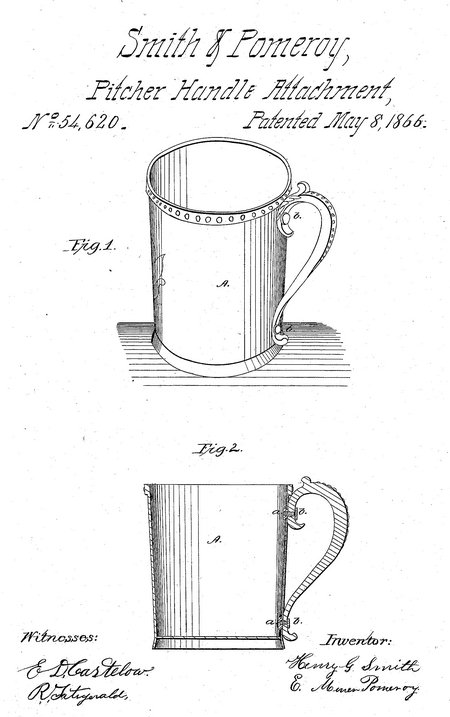Elisha Miner Pomeroy
- Born: 27 Dec 1828, Wallingford CT
General notes:
Silverplater
Events in his life were:

- He was issued patent number 54,620 on 8 May 1866
HENRY G. SMITH AND E. MINER POMEROY, OF WEST MERIDEN, CONN.
IMPROVEMENT IN FASTENING HANDLES TO PLATED WARE.
Specification forming part of Letters Patent No. 54,620, dated May 8, 1866.
To all whom it may concern:
Be it known that we, HENRY G. SMITH and E. MINER POMEROY, both of West Meriden, in the county of New Haven and State of Connecticut, have invented a new and useful Improvement in Attaching Handles, &c., to Plated Ware, &c.; and we do hereby declare that the following is a full, clear, and exact description of the construction, character, and operation of the same, reference being had to the accompanying drawings, which make part of this specification, in which—
Figure 1 is a perspective view of a cup or vessel with a handle attached, showing the outer ends or heads of the screws by which the handle is attached to the cup. Fig. 2 is a section of the same cut vertically through the center, showing both the male and the female screws and the entire character of the fastening.
Our improvement consists in attaching the handles, feet, and all other projecting parts, of gold, gilt, silver, plated britannia, &c., vessels, such as cups, pitchers, tea-pots, coffee-urns, and all other articles which are circular in their cross-section, (so far as the body of the article is concerned,) by means of screws, so that the article may be burnished or finished in a lathe before the handles, &c., are attached, and so that the handles, &c., may be removed for reburnishing, &c., when necessary.
We make the body of the cup, pitcher, or other article in the usual way, as represented at A, Fig. 1, and indicated in section in Fig. 2, except that we make as many holes in it as there will be screws needed to secure the handle, &c. In each of these holes, after the inside is finished, we fit plugs, with the outer ends tapped, as female screws, with the heads or buttons left solid on the inside of the vessel, as represented at a and a, Fig. 2, and we solder them firmly and water-tight in their places, so that the outer ends will exactly correspond with the outer or external surface of the cup or other vessel, as is represented in section in Fig. 2. We then burnish or finish the outside of the cup or other vessel in a lathe, after which we attach the handle, or any other part which projects beyond the periphery or convex surface of the cylindrical or circular part of any portion of its longitudinal extent, by means of male screws, as represented at & and &, Figs. 1 and 2.
We make the head or button part of the female screw of silver or white metal, or some other substance to correspond with the color of the inside of the vessel, and that will not be corroded or be acted on by any substance which the vessel may be used to dip, or to hold, or contain; or else we plate it.
The male screws we make of iron or any other suitable material, and have the heads capped or plated with silver, or finished in any other way which fancy or the state of the market may suggest.
This method is equally applicable for attaching feet or any externals, parts, or ornaments which would be in the way of burnishing or finishing in a lathe, so that they may be put on after the surface has been burnished or finished, and be removed when it is desirable to burnish or finish them again after being worn or injured.
What we claim as our invention, and desire to secure by Letters Patent, is—
Attaching handles and other projecting parts to cups, pitchers, and other analogous vessels made of plated or solid metal by means of male and female screws, when the screws are made and fitted in the manner and for the purposes substantially as herein described and set forth.
Henry G. Smith
E. Miner Pomeroy
Witnesses:
E. D. Castelow
E. Fitzgerald
- He appeared on the census in 1870 in Meriden CT. Listed as a plater.
- He appeared on the census in 1880 in Chatham CT. Listed as a plater at a coffin hardware shop
|